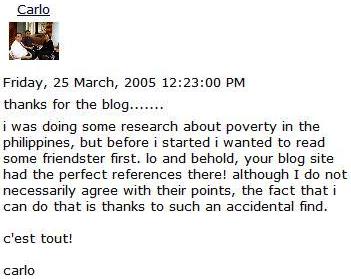It's not very often that librarians make it into the news in the Philippines. And so, even though I was planning on building up gradually to the state of public school libraries in the Philippines, let me just get this off my chest:
…[S]chool library conditions are not conducive to effective library service as required by modern education… Books are merely accessioned, but neither classified nor catalogued… This is accompanied by an unbalanced or disproportionate distribution of books… The housing conditions provided for the library, if any, are poor, and the furniture and equipment are inadequate… The library is not open long enough for students to use it to the fullest extent. Opening the library is only a matter of “if time permits” for the librarian. Some schools do not even open their libraries at all… Library instruction is given; but [it] is inadequate, disorganized, and has no definite place in the curriculum… The… librarians have not had any training in library work. Even liberally interpreting the term “trained librarian” to mean a librarian who has taken any course in library science, the data compiled show only 29 per cent who qualify as possessing “technical training.”
No, this is not from the latest news article about Filipino public school libraries. The findings quoted above were taken from a thesis written
65 years ago (Concordia Sanchez, “A Survey of Philippine Public Elementary School Libraries” [M.A. thesis, University of the Philippines, 1940]).
"
Public School Librarians are Have Nots," by Peachy Limpin (
Manila Bulletin, 6 March 2005),
is the latest news article about Filipino public school libraries. But it's not very encouraging:
I gave a brief lecture on information literacy two Fridays ago to public school librarians from Manila... [T]hey were all computer literate. This may not sound a bit surprising but seeing the audience composed of 40s and 50 something, I assumed that some might still be technophobic... what the librarians are afraid of is forgetting what they have learned since they are not using the system yet because most of the public school libraries have no computers in the first place... Another reality that struck me was that there was only one librarian from among those present who has ever used a search engine.
While it may seem good that the public school librarians were "computer literate"—because they had been taught to use computers—the fact that only one had "ever used a search engine" makes me wonder just how "computer literate" these librarians were. And what if Limpin had visited the libraries managed by the public school librarians who listened to her? She would have seen what most Filipino librarians—or any Filipino, for that matter—would instinctively know: that what Sanchez wrote about public school libraries in 1940 is still very true today. With or without "computer literate" librarians.
Please don't get me wrong. This is not a put down, just a statement of fact. In a future post, I will discuss why public school libraries in the Philippines have been neglected, and how a few have managed to flourish despite this neglect.
To understand the situation further, see "Scrounging Funds to Finance Public Schools in the Philippines" by Marites Sison (25 April 2000). Please note that this article is not about libraries but the schools themselves.
Read More...
Summary only...








